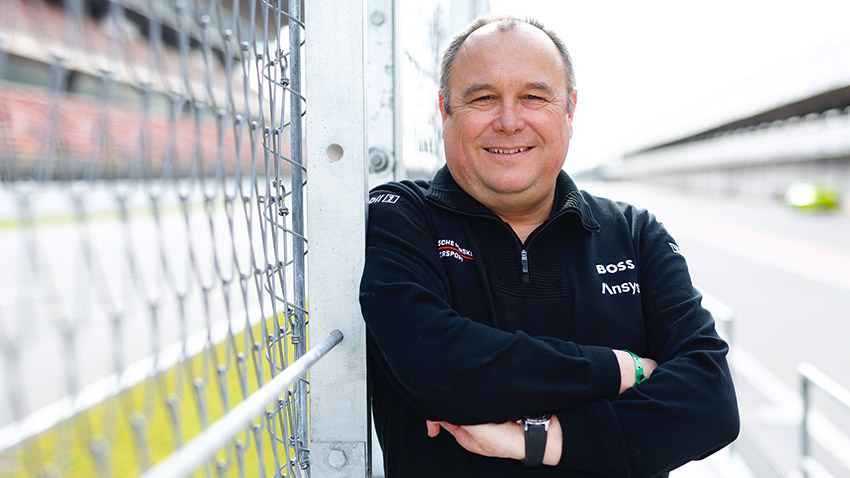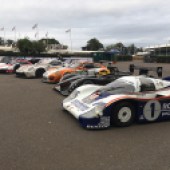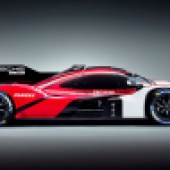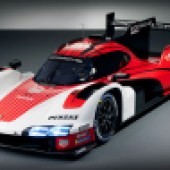The iconic marque is returning to what promises to be dream-like endurance racing from next year. Graham Keilloh finds out how preparations are going with the Porsche 963.
Words: Graham Keilloh.
Imagine World sportscar racing from your dreams. You might think of the 1980s model with Porsche 956s and 962s, the Rothmans works cars taking on a fleet of competitive privateers. Or you might think more broadly, of multiple manufacturers battling for overall victory in the great races on both sides of the Atlantic, topped by Le Mans and Daytona.
Well in 2023 it looks like we’re getting something like all of this, with LMDh regulations coming in alongside the Hypercar, and these regulations harmonised for the World Endurance Championship and IMSA in the United States.
And none other than storied Porsche has fired the starter pistol for it, at the recent Goodwood Festival of Speed becoming the first to give its LMDh car – the newly unveiled Porsche 963 – a public dynamic debut.

There will be four works Porsche 963 cars next year, two each in WEC and IMSA, and they – in a call back to the 1980s heyday mentioned at the outset – will also compete against privateer Porsche 963 teams, some of which have been confirmed already. All are seeking to build on Porsche’s unparalleled 19 Le Mans overall victories and much success elsewhere in endurance racing.
And Porsche’s towering endurance heritage is indeed central to this latest programme. “We’ve chosen the name 963 on purpose,” Porsche’s vice president motorsport Thomas Laudenbach smiles to Motorsport News. “It’s a homage on what we’ve done in the past, and we want to keep that momentum going and, looking at that, we at the same time we have a customer programme with these cars which we had in the past in a very successful way, so putting all these together it makes absolute sense.”
Timo Bernhard, Porsche’s Le Mans winner and twice WEC champion with the marque’s previous 919 venture, offers similar clarity to Motorsport News. “We look at the heritage, Porsche belongs to the big class, belongs to Le Mans, in the World Endurance Championship. They go together,” he notes.

“I like the name as well I have to say, the Porsche 963, because it gives a bit of heritage with the 962 which was a very successful customer car, not only a factory car, which is the same road they want to take [now].”
Laudenbach continues: “The door opener [was] that there’s the same set of rules in the American championship and the World championship because this gives you a lot of opportunities, that’s an efficient way. Obviously you need a certain amount of budget to build such a car but if you can race in the two championships it just gives you a wider range for customers.”
And adding considerably to this already towering heritage, Porsche is collaborating with Team Penske to run the works machines. The Porsche Penske Motorsport team will have bases either side of the Atlantic, its WEC branch in Mannheim and IMSA’s in Mooresville, North Carolina.
So, if it doesn’t seem a silly question, why has Penske been brought onboard? Laudenbach explains: “We took the global approach because we thought it’s beneficial if we have one car, one specification of car by the same organisation is handling it worldwide because this can be really beneficial with the changing data and stuff like that.”

Porsche Penske Motorsport managing director Jonathan Diuguid continues to MN: “European racing has a certain approach and factory racing has a certain approach, and we’ve dealt with many manufacturers over Penske’s time in racing and been successful on all fronts.
“So just bringing knowledge of what Penske has from a racing pedigree and what Porsche has from the endurance pedigree in their design side, it’s really a unique partnership that hasn’t been seen in motorsports for a while especially with two cars competing in two championships across the world and having one global team is something that’s very unique.”
Porsche’s director factory motorsport LMDh Urs Kuratle takes a similar view: “We were looking for a partner we can do both series [with] at the same time, IMSA and the WEC. Penske is the perfect fit and Penske also have a history with Porsche together, with the RS Spyder. It’s working perfectly.”
However being split across two locations, thousands of miles apart, often is a motorsport red flag. “It’s new for Penske,” Diuguid concedes. “We were in V8 Supercars and raced in Australia recently and we had some Formula 1 exposure back in the ’70s but this is really our most recent foray into European racing and we felt it was important to have a base in Europe, to have access to employees, personnel, to be closer to Porsche Motorsport and really have a home base to where we could operate out of and really participate in the WEC championship.
“Having two bases may make it more complicated in one sense but also we can take advantage of time zones and other things and transfer information and every day work really hard on learning.”
Porsche at Goodwood also confirmed eight drivers – including Andre Lotterer, Felipe Nasr and GT graduate Kevin Estre – for its WEC and IMSA pool, and two more pilots may be added. The Porsche 963 got 7900km of testing under its belt in the first half of 2022, and while the car’s competitive debut is slated for the Daytona 24-hour race early next year, it may get a run out in this autumn’s Bahrain WEC round depending on how testing goes.
So how are preparations progressing? “They’re going smoothly,” Diuguid says, “we’ve done a lot of kilometres, we still have goals that we need to meet.

“The first time the car’s going to go racing is the 24-hour race in Daytona, which we know is quite difficult to make the car last, the banking there and the high speeds that the car sees are really difficult. So we have a few more sign offs to get to that point where we can say ‘hey we’re ready to go racing’ and we’re going to work really hard over next six months to make sure we’re there.”
And have there been surprises with running the car with the new rules? “Oh there’s been all kinds of surprises,” Diuguid adds, “the main feedback is the hybrid cars are complicated, to have high-voltage electrical systems, electronic braking systems, brake-by-wire systems, throttle-by-wire systems.
“And getting all the things to work together and function properly to be seamless to where the car does what the driver expects it to do, there’s surprises all along the way. It’s all different levels of the system that we’ve had and we’ve had to address those and figure out how to make it work.”
Kuratle says: “We had some problems, we overcome some problems, but that’s I believe normal in the project stage we are right now as a prototype, with a completely new car, but we are also happy and satisfied how it goes.”

Porsche LMDh, Barcelona (E) Test, Thomas Laudenbach, Leiter Porsche Motorsport
Adding to the challenge of course, is that with new rules there’s little way of knowing what your rivals are up to at the same time. “Yeah, but that goes for everybody,” Kuratle says. “At least we are on the road, we are the first one to test the car. It’s normal exciting times because we don’t know what the others do but again it’s the same for them.
“They [the drivers] love it so far. Of course it’s not only positive feedback from the drivers because it’s not a show drive it’s a test drive if you are on the track and they will tell us what they don’t like, but this is what we are asking the drivers, we are asking what can we do better. But in general they are all excited and they are top motivated to drive that thing.”
Diuguid adds: “We’ve got a really experienced driver crew and we can rely on their feedback of how the car is handling and that performance so I think we’re in a good spot.”
Throughout too is clear sense that Porsche is returning to a world endurance formula that is, at last, on the way up.

Porsche LMDh, Barcelona (E) Test, Urs Kuratle (Director Motorsport Operations, Porsche AG)
Diuguid says: “It’s a unique time in endurance racing where we haven’t had more than two or three manufacturers compete for the overall win [for some time], and [we’re now] talking about the possibility of eight manufacturers competing for overall wins in all these races.”
Driver Lotterer is similarly excited. “[It] should be good racing for sure,” he tells MN. “A lot of competition, more than 20 cars heading for victories, it’s a while since we’ve had that prestige.
“[The Porsche 963 is] not as quick as the LMP1 cars but it still feels still feels great and very quick on the straight line.”
As for Lotterer having privateer Porches to take on too, “that’s great news,” he says, “it shows that the platform is good and will be sustainable for many years to come so. And for Porsche if it’s a privateer winning it’s still a Porsche win.”
And Porsche itself, with everything we’ve said, will be a cornerstone of the promised healthy world sportscar landscape. And the considerable heritage is not weighing down its latest effort.
“I mean that’s huge, it increases the pressure,” Kuratle admits. “At Le Mans we did the 19 victories, I was happy enough to be part of the LMP1 team back then, we did the 17, 18 and 19 victory, now everybody is asking for the 20th victory, and that increases the pressure yes. But that’s a great possibility, it’s exciting.”

“It’s a positive level of pressure,” concurs Diuguid, “and the thing behind the heritage is much like Team Penske is everybody is willing to do whatever it takes to win and work as hard as possible and test as much as possible and put forward as much effort. And there’s levels of expectation and a pressure of expectation but I would say it’s a positive pressure and it’s a positive level of expectation because of the support systems that we have and the people that we work with.”
Bernhard sums up the matter: “For sure it gives a certain amount of pressure because every [previous] programme was successful, so for sure this will be measured as well with the success that previous competitions had. But that’s also like a motivation.”


















